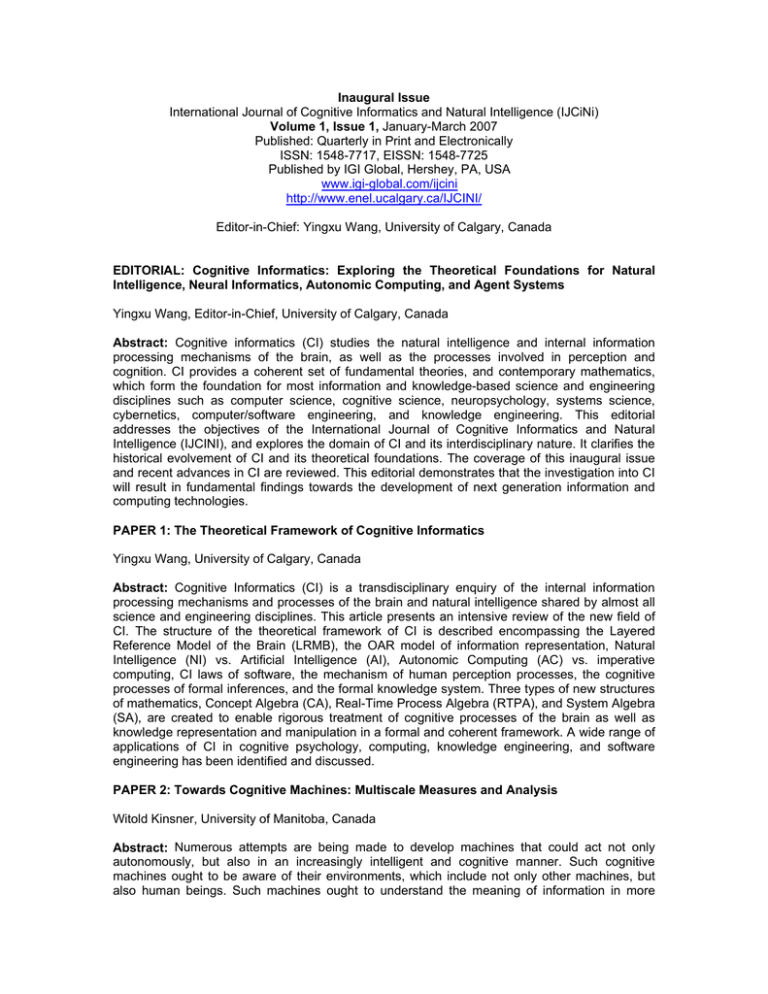Inaugural Issue International Journal of Cognitive Informatics and
advertisement

Inaugural Issue International Journal of Cognitive Informatics and Natural Intelligence (IJCiNi) Volume 1, Issue 1, January-March 2007 Published: Quarterly in Print and Electronically ISSN: 1548-7717, EISSN: 1548-7725 Published by IGI Global, Hershey, PA, USA www.igi-global.com/ijcini http://www.enel.ucalgary.ca/IJCINI/ Editor-in-Chief: Yingxu Wang, University of Calgary, Canada EDITORIAL: Cognitive Informatics: Exploring the Theoretical Foundations for Natural Intelligence, Neural Informatics, Autonomic Computing, and Agent Systems Yingxu Wang, Editor-in-Chief, University of Calgary, Canada Abstract: Cognitive informatics (CI) studies the natural intelligence and internal information processing mechanisms of the brain, as well as the processes involved in perception and cognition. CI provides a coherent set of fundamental theories, and contemporary mathematics, which form the foundation for most information and knowledge-based science and engineering disciplines such as computer science, cognitive science, neuropsychology, systems science, cybernetics, computer/software engineering, and knowledge engineering. This editorial addresses the objectives of the International Journal of Cognitive Informatics and Natural Intelligence (IJCINI), and explores the domain of CI and its interdisciplinary nature. It clarifies the historical evolvement of CI and its theoretical foundations. The coverage of this inaugural issue and recent advances in CI are reviewed. This editorial demonstrates that the investigation into CI will result in fundamental findings towards the development of next generation information and computing technologies. PAPER 1: The Theoretical Framework of Cognitive Informatics Yingxu Wang, University of Calgary, Canada Abstract: Cognitive Informatics (CI) is a transdisciplinary enquiry of the internal information processing mechanisms and processes of the brain and natural intelligence shared by almost all science and engineering disciplines. This article presents an intensive review of the new field of CI. The structure of the theoretical framework of CI is described encompassing the Layered Reference Model of the Brain (LRMB), the OAR model of information representation, Natural Intelligence (NI) vs. Artificial Intelligence (AI), Autonomic Computing (AC) vs. imperative computing, CI laws of software, the mechanism of human perception processes, the cognitive processes of formal inferences, and the formal knowledge system. Three types of new structures of mathematics, Concept Algebra (CA), Real-Time Process Algebra (RTPA), and System Algebra (SA), are created to enable rigorous treatment of cognitive processes of the brain as well as knowledge representation and manipulation in a formal and coherent framework. A wide range of applications of CI in cognitive psychology, computing, knowledge engineering, and software engineering has been identified and discussed. PAPER 2: Towards Cognitive Machines: Multiscale Measures and Analysis Witold Kinsner, University of Manitoba, Canada Abstract: Numerous attempts are being made to develop machines that could act not only autonomously, but also in an increasingly intelligent and cognitive manner. Such cognitive machines ought to be aware of their environments, which include not only other machines, but also human beings. Such machines ought to understand the meaning of information in more human-like ways by grounding knowledge in the physical world and in the machines’ own goals. The motivation for developing such machines range from self-evidenced practical reasons, such as the expense of computer maintenance, to wearable computing in health care, and gaining a better understanding of the cognitive capabilities of the human brain. To achieve such an ambitious goal requires solutions to many problems, ranging from human perception, attention, concept creation, cognition, consciousness, executive processes guided by emotions and value, and symbiotic conversational human-machine interactions. An important component of this cognitive machine research includes multiscale measures and analysis. This article presents definitions of cognitive machines, representations of processes, as well as their measurements, measures, and analysis. It provides examples from current research, including cognitive radio, cognitive radar, and cognitive monitors. PAPER 3: Neo-Symbiosis: The Next Stage in the Evolution of Human Information Interaction Douglas Griffith, General Dynamics Advanced Information Systems, USA Frank L. Greitzer, Pacific Northwest National Laboratory, USA Abstract: This article re-addresses the vision of human-computer symbiosis as originally expressed by J.C.R. Licklider nearly a half-century ago and argues for the relevance of this vision to the field of cognitive informatics. This vision is described, placed in some historical context relating to the evolution of human factors research, and it is observed that the field is now in the process of re-invigorating Licklider’s vision. A central concept of this vision is that humans need to be incorporated into computer architectures. The state of the technology within the context of contemporary theory and practice is assessed, and the authors describe what is regarded as this emerging field of neo-symbiosis. Examples of neo-symbiosis are provided, but are nascent examples and the potential of neo-symbiosis is yet to be realized. The authors offer some initial thoughts on requirements to define functionality of neo-symbiotic systems and discuss research challenges associated with their development and evaluation. Methodologies and metrics for assessing neo-symbiosis are discussed. PAPER 4: Representing an Intrinsically Nonmetric Space of Compass Directions in an Artificial Neural Network Michael R.W. Dawson, University of Alberta, Canada Patricia M. Boechler, University of Alberta, Canada Abstract: This article trains an artificial neural network to make a judgment that is intrinsically antisymmetric, and determines how such a judgment is mediated by the network’s internal representations. One key component of navigation is judging the distance from one location to another. A second key component of navigation is judging heading – that is, judging the direction from one location to another. Importantly, heading judgments do not preserve the metric properties of space. In particular, they are antisymmetric: the judged heading from location x to location y should be opposite to the judged heading from location y to location x. What kind of representation can mediate such nonmetric navigational judgments? To explore this question, the authors trained an artificial neural network to judge the various bearings amongst 13 different cities in Alberta. The internal structure of this network is interpreted the in order to determine the nature of its internal representations. PAPER 5: Language, Logic, and the Brain Ray E. Jennings, Simon Fraser University, Canada Abstract: Although linguistics may treat languages as a syntactic and/or semantic entity that regulates both language production and comprehension, this article perceives that language is a physical and a biological phenomenon. The biological view of languages presents a new metaphor on an evolutionary time-scale the human brain and human language have co-evolved. Therefore, the brain is the instrument with a repository of syntactic and semantic constraints. The logical vocabulary of natural languages has been understood by many as a purified abstraction in formal sciences, where the internal transactions of reasonings are constrained by the logical laws of thought. Although no vocabulary can be entirely independent of semantic understanding, logical vocabulary has fixed minimal semantic content independent of context. Therefore, logic is centered in linguistic evolution by observing that all connective vocabulary descends from lexical vocabulary based on spatial relationship of sentences. Far from having fixed minimal semantic content, logical vocabulary is semantically rich and context-dependent. Many cases of mutations in logical vocabulary and their semantic changes have been observed as similar to that of biological mutations. These changes proliferate to yield a wide diversity in the evolved uses of natural language connectives. EVENT REPORT: Cognitive Informatics, Four Years in Practice: A Report on IEEE ICCI’05 Du Zhang, California State University, USA Witold Kinsner, University of Manitoba, Canada Jeffrey Tsai, University of Illinois, USA Yingxu Wang, University of Calgary, Canada Philip Sheu, University of California, USA Taehyung Wang, California State University, USA Abstract: The 2005 IEEE International Conference on Cognitive Informatics (ICCI’05) was held during August 8th to 10th 2005 on the campus of University of California, Irvine. This was the fourth conference of ICCI [Kinsner et al. 05]. The previous conferences were held at Calgary, Canada (ICCI’02) [Wang et al. 02], London, UK (ICCI’03) [Patel et al. 03], and Victoria, Canada (ICCI’04) [Chan et al. 04], respectively. ICCI’05 was organized by General Co-Chairs of Jeffrey Tsai (University of Illinois) and Yingxu Wang (University of Calgary), Program Co-Chairs of Du Zhang (California State University) and Witold Kinsner (University of Manitoba), and Organization Co-Chairs of Philip Sheu (University of California), Taehyung Wang (California State University, Northridge), and Shangping Ren (Illinois Institute of Technology).



